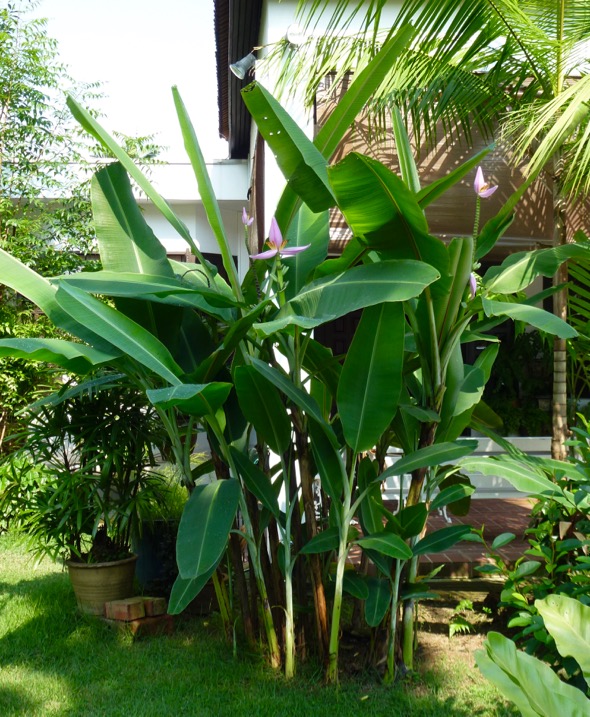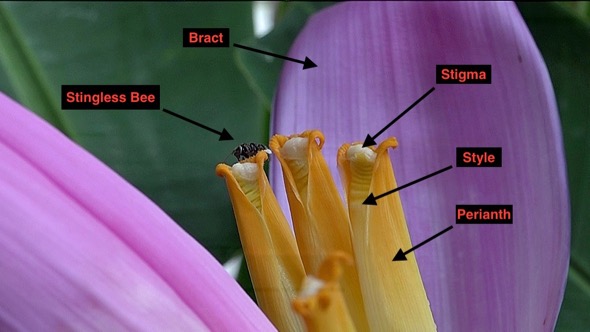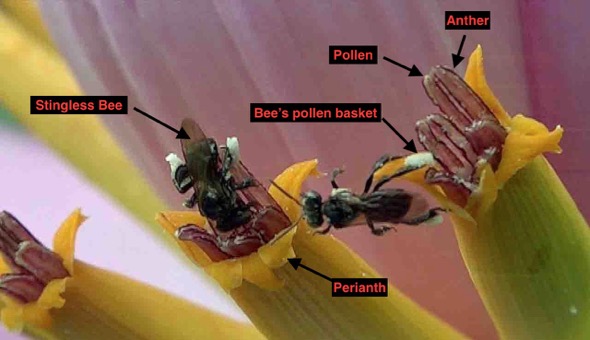
The Ornamental Banana (Musa ornate) is a dwarf banana plant with attractive pink flowers (above). Flowers are unisexual. Male and female flowers are packed between layers of bracts in the same compact inflorescence. As the first few bracts unfold, the female flowers are exposed. Subsequent bracts higher up the inflorescence bear male flowers.

Stingless Bees (Trigona sp) are attracted to the female flowers (above). Not sure what actually attracts these bees. Maybe the smell of nectar? But nectar is found at the base of flowers, inaccessible to these tiny bees.
The female flowers also attract Olive-backed Sunbirds (Cinnyris jugularis). But the sunbird’s bill, although longer than most birds, is too short to allow for the tongue to reach the base of the flower where the nectar is. So what do they do? Both male and male eclipse sunbirds seen in the video below puncture the base of the flower with their sharp bill to “steal” the nectar. This way the sunbirds do not help in the pollination of the flowers, thus the term “steal”.
After the female flowers the male flowers are exposed on the inflorescence. More Stingless Bees are seen hovering around the tip of the male than the female flowers. This is because of the presence of masses of pollen after the pollen sacs (anthers) burst open to liberate them (below).
The Stingless Bees crawl around the tips of the pollen sacs to gather the white pollen. The bees’ pollen baskets, found on the upper surface of the pair of hind legs, are packed with white pollen loads. When the bees return to their nest, the pollen loads are transferred to clusters of small resin pots for later use.
Olive-backed Sunbirds similarly visit the male flowers to harvest nectar (video below). Again, they “steal” the nectar by probing around the base of the flowers LINK.
The normal way of harvesting nectar in this banana is seen with spiderhunters that have longer bills (below). With a bill that is long enough to reach the nectar at the bottom of the flowers, the bill ends up covered with pollen. These are transferred to a female flower should the spiderhunter visits it afterwards LINK.
![Grey-breaster Spiderhunter harvesting nectar (Photo credit: Dr Amar-Singh HSS]](https://besgroup.org/wp-content/uploads/SpiderhunterGrBr-Musa-ornata-AmarSingh-2-1.jpg)
Olive-backed Sinbirds are common in my garden but not spiderhunters. And in the absence of spiderhunters, pollination of these ornamental banana plants is left to the Stingless Bees. But do these Stingless Bees actually pollinate the female flowers?
YC Wee
Singapore
26th April 2017










One Response
Hello sir,
I am student of IIT-Guwahati India, and currently working on Haploid production in Banana. An interesting question come out during my first lab presentation from my professor, if the flower are divided into two section i.e the first part as female flower and the latter part as male flower then how fertilization occur in diploid banana plant. since when the female flower bract were open, that time the male flower were still under the bract unopen. then how fertilization takes place in diploid banana plant.
I am still not much clear with the process of fertilization in banana even after watiching you videos.
I will be very much helpful if you provide answer to my question.
Do mail me the answer in [email protected]
Thank you
Arabindu Debbarma.